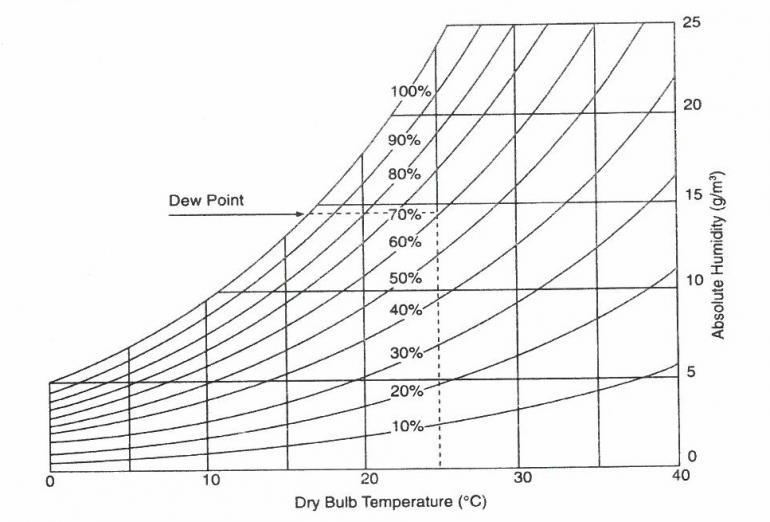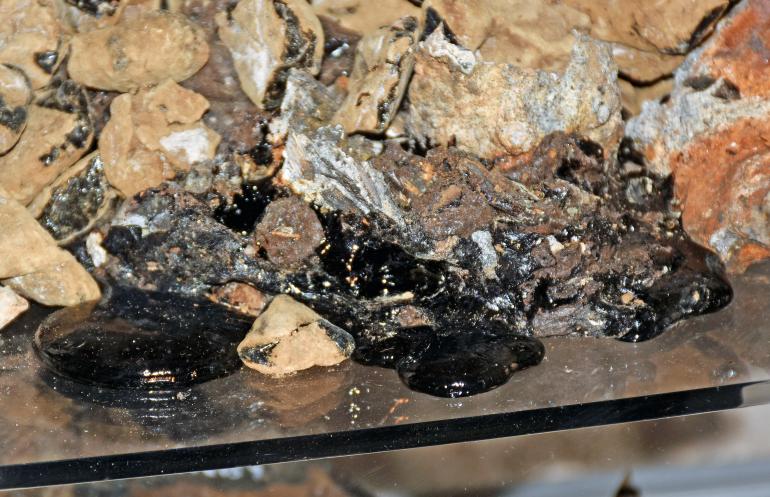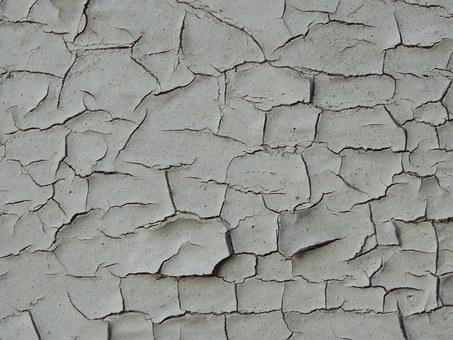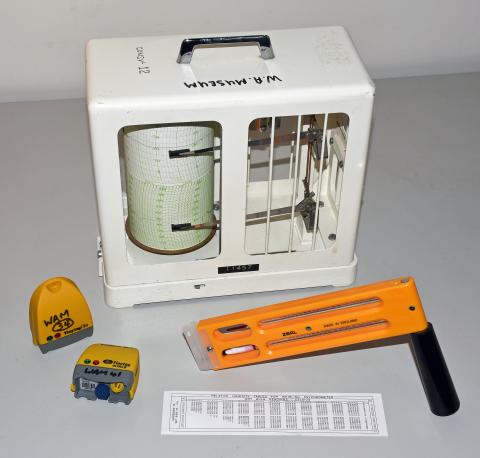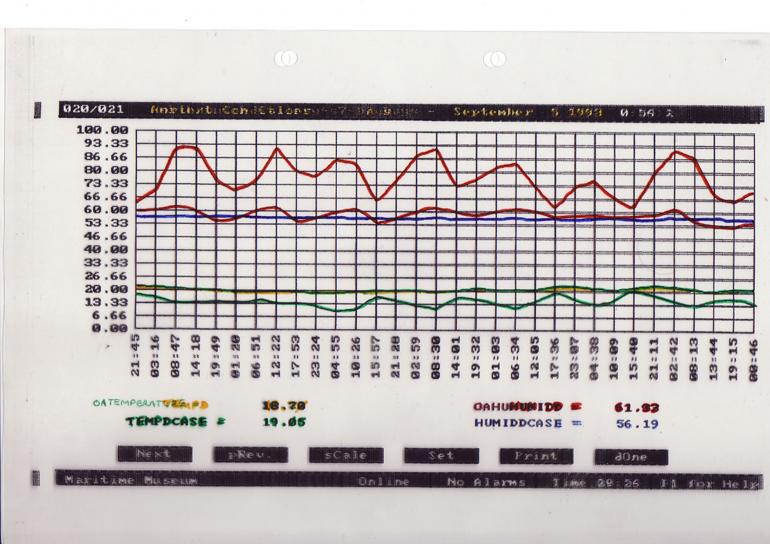Relative Humidity and Temperature
These deterioration factors are considered together because of their close inter-relationship.
Principles
The relative humidity (RH) of the air is an indication of how much water vapour is in the air at a particular temperature compared with how much water vapour the air could actually hold at that temperature. It is expressed as a percentage and can be defined as follows:
| RH = | amount of water in a given amount of air | x | 100 |
| max. amount of water the air can hold at that temperature | 1 |
Air at 100 % relative humidity holds the maximum amount of water possible at that particular temperature and is said to be saturated. Saturated air at 10 °C holds about 10 grams per cubic metre (g/m3) of moisture; at 20 °C about 17 g/m3 and at 30 °C more than 30 g/m3. Put simply, the relative humidity is a measure of the percentage saturation of the air. Therefore air at 50% relative humidity, regardless of temperature, is holding half of its total possible water capacity.
In essence, cold air cannot hold as much water vapour as warm air. In a closed environment such as a display case, there will be a fixed amount of water vapour, referred to as the absolute humidity. If the temperature inside the case falls then the relative humidity will rise. If the temperature rises the relative humidity will fall. Such changes in relative humidity could be caused by many factors including direct sunlight, spotlights and air-conditioning failures.
Figure 3: Hygrometric chart (adapted from Thomson 1986).
The hygrometric chart above (Figure 3) illustrates that a relative humidity of 60 % in a well-sealed display case kept at 25 °C will rise to about 80 % relative humidity if the temperature falls to 20 °C. Dew point will be reached if the temperature falls to about 16 °C. Condensation will then occur.
Deterioration Effects
Damage caused by either changes in temperature and relative humidity or by exposure to inappropriate levels of these agents may be either chemical, physical or biological in nature (Figure 4). The main impacts of temperature, unless they are extreme enough to freeze or melt objects, are on relative humidity and the rate of chemical deterioration of objects. A 10 °C rise in temperature for example, approximately doubles the rate at which chemical reactions proceed.
Figure 4: Tar creep induced by warm gallery temperatures.
After light, relative humidity is the most significant factor to be considered in the environmental control of collections. Constant relative humidity above 70 % can cause mould growth and increase corrosion whereas relative humidity levels below 40 % may cause sensitive materials such as paper, parchment and textiles to become brittle.
It is important not only to control relative humidity levels but also to minimise fluctuations. Large and rapid changes in relative humidity caused by sudden temperature variations can have significant effects on materials. A sudden drop in temperature in a display case for example, may result in the dew point being reached. The subsequent condensation will accelerate metal corrosion and encourage biological attack on susceptible organic materials.
Organic materials such as paper, wood, textiles, bone and ivory expand and contract as they absorb and release water in response to changes in relative humidity levels. Rapid fluctuations can lead to cracking and warping of these materials and also cause bonded materials to separate. Paint for instance, may craze or peel from wooden surfaces (Figure 5) and paper glued to a backing board may buckle.
Figure 5: Paint damage due to differential expansion of the underlying wood and the paint layers.
Temperature and Relative Humidity Guidelines
While temperatures in museum display spaces are often designed for visitor comfort rather than for object preservation, conditions in storage areas are usually more carefully defined and controlled (see recommendations for particular material types in other chapters).
For many years the recommended ideal temperature and relative humidity conditions for museum collections were specified as 20 °C and 50 % respectively. These conditions, that were experientially based rather than scientifically determined, are difficult to maintain unless expensive air conditioning systems are used and may not be possible or even desirable in certain areas. In the tropics for instance, where the average yearly relative humidity is about 65 %, it may be better to have this as the optimum level (combined with air circulation) whereas in an arid region it may be better to aim for a relative humidity range of 40 - 50 %. This not only saves on energy costs but also means that material which is conditioned to the ambient relative humidity will not be damaged by change. The following temperature and relative humidity ranges were recommended, on a daily basis for particular climatic zones (Heritage Collections Council 2002):
- hot, humid climates, 22 – 28 °C, 55 – 70 %
- hot dry climates, 22 – 28 °C, 40 – 60 %
- temperate climates, 18 - 24 °C, 45 – 65 %
Storage and/or display of objects in appropriate environments contribute significantly to their longevity. The key is to determine just what the most appropriate environments are for the objects under consideration. Most of the uncertainty with the specification of relative humidity conditions is associated with organic and mixed media materials whereas the conditions for inorganic materials like metals and ceramics are generally more clearly defined.
Since the early 1990s, many scientific studies have been devoted to determining the most appropriate environmental conditions for the storage and display of objects. Early work by Michalski (1993) and Erhardt and Mecklenburg (1994) suggested that although certain material types benefit from storage in strictly controlled conditions, most mixed materials in sound order only need be maintained in environments within a relative humidity range of 40 - 70 %. A relative humidity fluctuation of ± 5% was suggested for sensitive objects (Michalski 1993).
Continued study in this area further refined relative humidity guidelines, with relative humidity variations within the range 30 – 60 % then considered mechanically safe for general collections (Erhardt et al, 2007). More stable conditions must be maintained however for certain degraded objects (veneers and inlays etc) and where possible, lower relative humidity conditions should be maintained for most metal objects. In 2014 following much debate, the Australian Institute for the Conservation of Cultural Materials (AICCM) recommended the following conditions as ‘interim’ guidelines for general collection materials:
- Temperatures to be maintained within the range 15 – 25 °C, with a maximum variation of ± 4 °C in any 24 hour period.
- Relative humidity levels to be maintained within the range 45 – 55 % with a maximum variation of ± 5 % in any 24 hour period.
In addition, the AICCM also recommended that relative humidity control be managed carefully to ensure that where conditions vary seasonally, the relative humidity for collections be maintained within the range of 40 – 60 %.
These more relaxed guidelines were determined after considering the possible impact these changes may have on the preservation of general collections, the need to make collection care more sustainable (especially in light of climate change) and to reduce the carbon footprint and high costs associated with the maintenance of tighter collection conditions. This latter point is significant as previous guidelines were difficult to maintain in most situations without the use of expensive, high energy air-conditioning systems. Similar guidelines to those of the AICCM were also recommended by the American Institute for Conservation (AIC) and endorsed by the International Institute for Conservation of Historic and Artistic Works (IIC) and the International Council of Museums Conservation Committee (ICOM-CC). In fact these latter groups recommended that the ‘interim’ guidelines recommended by the AICCM and the AIC should not be considered as interim but as guidelines per se. Further, the IIC and ICOM-CC groups also recommended that collection care should be achievable for local climates and that consideration should be given to more use of passive methods for environmental control, to the use of simpler technologies, air circulation and lower energy systems.
Conservation management of environmental parameters has also changed somewhat, tending to move away from the specification of strict guidelines (apart from those for particular material types such as acetate films, weeping glass etc) to the adoption of a risk analysis approach. Risk analysis requires an examination of the relationship between the environment and the objects in that particular environment. If the objects are stable within their usual environment then there is little point in altering those conditions. Thus instead of blindly following the strict temperature and relative humidity guidelines specified by many of the larger cultural institutions, anecdotal evidence suggests that it may be better to try to maintain the local conditions to which objects have become acclimatised. This is, of course on the proviso that an appropriate investigation has revealed that these conditions have not caused damage to sensitive objects.
In conjunction with determining the most appropriate relative humidity set point, it is most important to attempt to reduce diurnal and seasonal fluctuations. It is well known that the smaller the fluctuations, the lower the risk of physical damage to susceptible objects. Depending on the chosen relative humidity set point, say 55 %, a variation in daily relative humidity of 5 % from that value would be considered safe for hygroscopic collections, a variation of 10 % would pose a low risk to most organic materials while variations of greater than 20 % would constitute a significantly increased risk to those types of collections.
For most materials, as long as the conditions return to a value close to the original, extreme short-term fluctuations may not be a problem as there is not enough time for objects to respond. Very thin objects however, are much more susceptible to damage from short-term fluctuations than larger more massive objects. These latter objects can take up or lose more moisture without physical impacts becoming evident than can smaller moisture sensitive objects.
Note that for objects containing more than one material type, the relative humidity level of the storage environment should reflect the recommended conditions for the most sensitive component.
Measurement
Relative humidity may be measured by using any of the following devices (Figure 6):
- sling psychrometer;
- thermohygrograph;
- hair hygrometers;
- calibrated electronic devices which provide a digital readout of temperature and RH; and
- data loggers linked to relative humidity sensors
Figure 6: Temperature and relative humidity data loggers (front left), sling psychrometer (front right) and thermohygrograph (rear middle).
One of the simplest instruments for measuring relative humidity is the sling psychrometer. This device is also known simply as the ‘sling’ or as a whirling hygrometer. It consists of two matched thermometers mounted side-by-side, one of which has a fabric sleeve covering it. The end of this sleeve is inserted into a reservoir which is filled with distilled water. The fabric-covered thermometer is known as the wet bulb, the other the dry bulb. When the thermometers are swung around, the water in the sleeve of the wet bulb evaporates, making it cooler than the dry bulb. The amount of evaporation and subsequent cooling depends on the amount of moisture present in the air - the drier the air the greater the level of cooling and vice versa. The difference in the temperatures of the thermometers therefore indicates how dry or humid the air is - the greater the difference the lower the ambient relative humidity, the smaller the difference the higher the relative humidity. A standard hygrometric chart, which displays a series of wet and dry bulb temperature differences and corresponding dry bulb temperatures, is then used to give an accurate measure of the relative humidity.
The sling is used to calibrate many other types of hygrometers. Coupled with a thermohygrograph (seven-day or one-month) an accurate day-to-day or hour-to-hour record of temperature and humidity can be obtained all year round. An advantage of a thermohygrograph is that the recent temperature and relative humidity history of the space being monitored is immediately visible on its chart.
Electronic instruments are also available which record changes in temperature and relative humidity. These devices vary greatly in price and can be obtained from electronic shops or conservation suppliers. These instruments have certain advantages. For example, they may be placed relatively unobtrusively in display cases or in small storage areas in which a thermohygrograph either would not be appropriate or would not fit.
Other relative humidity sensors linked to data loggers can be programmed to record temperature and relative humidity conditions at regular intervals over periods of many months. These sensors are very small and by operating continuously over the different seasons allow useful long-term profiles to be established of storage and display conditions.
Monitoring relative humidity is important to determine both the actual levels and the fluctuation rates. This information may be used to see how well a building buffers the external ambient conditions and also to see how well a display case further buffers the gallery environment (Figure 7). If the temperature is steady then the relative humidity within a well-sealed display case will remain constant.
Controlling Relative Humidity and Temperature
Relative humidity and temperature control strategies include the use of:
- the buffering effects of buildings and storage media;
- moisture-absorbing desiccants (silica gel and zeolites);
- natural moisture-absorbing materials such as wood, paper and textiles;
- refrigerant dehumidifiers;
- air conditioning systems; and
- thorough and well-planned building maintenance.
We strongly recommend the use of passive methods for temperature and relative humidity control as these are often more sustainable and cost-effective. Appropriate design of buildings and storage media, the use of insulating materials and good management practices are critical components of passive environmental control. These methods are much preferred to more costly and often less reliable air conditioning systems.
Fluctuations in temperature and relative humidity are caused by daily and seasonal fluctuations in the local weather. Even without air conditioning, the insulating effect of a building ensures temperature and relative humidity variations inside a building are generally smaller than those outside. The conditions in the innermost rooms will be the most stable, outer rooms and lofts the most variable and basements the most vulnerable to the development of high relative humidity levels. Thermal insulation of a building will assist in maintaining more stable conditions. The provision of shading (north side of a building in the southern hemisphere) and the use of reflective building surfaces will also assist in reducing the impacts of exterior conditions on interior environments.
Cupboards, boxes and display cases are secondary insulating barriers which provide an additional buffer, helping to stabilise conditions even more (Figure 7). It is interesting to note that the books in a library provide a significant amount of the buffering of the internal library environment.
Figure 7: Temperature and relative humidity readings showing the differences between external conditions, those in an exhibition gallery and in a display case. The uppermost readings highlight the strong buffering of relative humidity inside a display case.
Depending on the internal and external climatic conditions, careful ventilation of a building can also be used to adjust the internal relative humidity. Accurate measurement of the respective relative humidity levels (interior and exterior) is essential for this strategy to be successful.
The climate within an individual showcase or cabinet can be controlled if material particularly sensitive to high relative humidity levels is to be stored or displayed. If the relative humidity is too high (above 65 %) then it may be necessary to use a desiccant within the display case to absorb excess water vapour. Orange self-indicating silica gel can be used for this purpose. Do not use the blue self-indicating silica gel as the cobalt chloride colouring is considered to be carcinogenic. It is important that any silica gel used in display cases is conditioned to the desired relative humidity level prior to being placed in the storage or display space. This process is best left in the hands of conservators as there is a risk of too much moisture being absorbed, resulting in desiccation of vulnerable objects.
Commercial conservation materials such as Art Sorb are also available. They are very useful in helping to control relative humidity levels in display cases and similarly sized containers. Art Sorb is a silica-based material, pre-conditioned to relative humidity levels of either 40, 50 or 60 %. Art Sorb is available in pellet, sheet or cassette form, depending on the nature of the space in which it is to be used. Sheets are generally only available buffered to 50 %.
Zeolite pellets may be of use in climatic areas in which the endemic relative humidity is naturally high (Australian Library and Information Association 1989). A Japanese researcher has developed a treated natural zeolite pellet capable of absorbing and releasing large amounts of water vapour. The pellets have been combined with Japanese paper with the resultant material being produced as a sheet or a paper-covered honeycomb board filled with pellets. Incorporating these materials in storage and display cabinets will minimise relative humidity fluctuations.
Zeolites have the added advantage of being able to absorb odours and as such, have been manufactured and sold commercially in packet or bag form for use in the home. They have been used to lower the relative humidity and absorb odours in refrigerators. If contemplating the use of these products always check their effect in the space in which they are to be used. This is important so that the risk of desiccation, or even inadequate dehumidification, is minimised.
An alternative way of controlling relative humidity levels is to incorporate other materials that absorb moisture, such as treated wood, paper and textiles in the cabinet or display case with the moisture-sensitive artefacts. These water-absorbing materials reduce relative humidity fluctuations by taking up or releasing moisture as conditions change. In this way the artefact is subjected to smaller relative humidity variations. Materials used in this way must be compatible with the moisture-sensitive object. It would not be appropriate for instance, to store a lead object in an oak box or to use alkaline-buffered acid-free tissue paper with leather objects.
In Japan this type of approach is used to deal with the naturally high humidity experienced in that country. Objects are stored in wooden chests in wooden buildings to take advantage of the natural moisture-absorbing and releasing properties of wood. In this way the box contents are buffered against both the naturally high relative humidity and against any changes in external conditions. The relative humidity range inside a Karabitsu (lacquered Japanese cedar chest) for instance, ranged from 60 – 65 % compared to the ambient conditions of 42 – 80 % (Kikkawa and Sano 2008). This approach would not be suitable for all material types however, especially those sensitive to the acidic vapours given off by wood. With the right choice of wood (hoop pine for example) and wrapping of artefacts in acid-free tissue, this approach may allow some of the problems associated with endemically high relative humidity conditions to be overcome without the need for more costly and active intervention.
Alternatively, if passive methods such as those outlined above are not sufficient, this problem may be tackled by lowering the relative humidity of the storage or display area itself. This can be achieved by employing a thermostatically controlled refrigerant dehumidifier to remove excess moisture. As mould formation is encouraged by conditions of high relative humidity, warm temperatures and stagnant air, it may be necessary to employ a combination of dehumidification, air circulation and temperature control. The use of fans within a room will assist in preventing the establishment of ‘dead’ spots in which localised high relative humidity microenvironments may otherwise be established.
Refrigerated air coolers can remove moisture from a building or room by condensing it outside. Water collected by this process is pure enough for use in the sling psychrometer.
Air conditioning systems should not be regarded as the first step in stabilising environmental conditions. While they are very good at maintaining appropriate temperatures, their impact on relative humidity control is highly variable, with higher fluctuations often being recorded following the installation of air conditioning systems. This is particularly the case when air conditioning operates intermittently. If the aim of air conditioning is to maintain objects in the best possible conditions then the system should run for 24 hours a day. If the air conditioning is turned off overnight the environment inside the building will tend towards external values. In winter a lowering of temperature in a well-sealed building will result in an increase in relative humidity. When the air conditioning plant is turned on in the morning there will be a rapid increase in temperature accompanied by a rapid decrease in relative humidity. These rapid changes in relative humidity should be avoided. It is obviously better to use passive controls to minimise fluctuations in environmental conditions.
Air conditioning systems which incorporate humidity control are available but these tend to be very expensive to set up, run and maintain.
It is important to prevent the development of extreme conditions of temperature and relative humidity. Usually such extremes are localised and often only affect a few objects. For example, localised heating and consequent low relative humidity may be caused by direct sunlight falling on an object, by having spotlights positioned too close or by having radiators or heaters adjacent to an object. It is also important to position sensitive objects away from the incoming air stream of air conditioning systems. This allows the incoming air to mix and equilibrate with the bulk of the air in the room before reaching a sensitive object, thereby minimising the impact of relative humidity fluctuations.
A common cause of high humidity is leakage of rainwater through the roof or walls. It is wise not to place objects or shelving against external walls as damp and localised extremes of both temperature and relative humidity are likely. Common sense and adequate building maintenance will minimise such problems.













